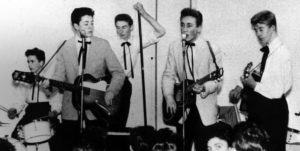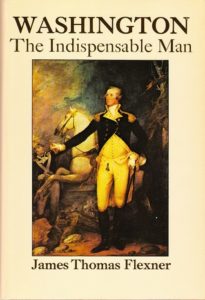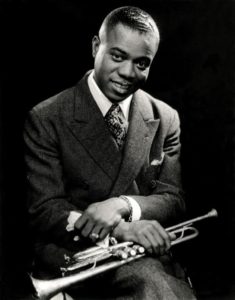
We mark the death on July 6, 1971 – 49 years ago today – of the jazz trumpet-player, singer, bandleader, and American icon Louis Armstrong. (For our information, Armstrong pronounced his first name as “Lewis”, as shall we.) Known alternately as Louis (as in LOO-wee), “Satchmo”, “Satch”, or simply “Pops”, Armstrong was the “indispensable” man of jazz.
One brief but, I think, most worthy item of date appropriate business to mention before moving on to Maestro Armstrong, an event that occurred on this date in 1957, 63 years ago today. That was the day that Paul McCartney and John Lennon met for the first time.
In November of 1956, two high school students – John Lennon (1940-1980) and his friend, the guitarist (and later, dry cleaner) Eric Griffiths (1940-2005) – founded a band in their hometown of Liverpool. They initially called the band the Blackjacks but quickly renamed it the Quarrymen, in honor of their high school, Quarry Bank High School. By early 1957, the band numbered six members. Lennon designed a poster which was put up across Liverpool, which informed its readers that “Country-and-western, rock ‘n’ roll, skiffle band — The Quarrymen — Open for Engagements.”

On July 6, 1957, the band was engaged to play at the St. Peter’s Church “Rose Queen” garden festival in the high-end Liverpool suburb of Wooten. At 4:15 pm they began a set on a stage set up behind the church; it was during this set that Paul McCartney (born 1942) arrived to hear the Quarrymen play. When the band had finished playing McCartney was introduced to John Lennon. Eager to show Lennon what he could do, McCartney picked up a guitar and played and sang Eddie Cochran’s Twenty Flight Rock, Gene Vincent’s Be-Bop-A-Lula, and a medley of songs by Little Richard. Lennon was indeed impressed, even more so when McCartney showed Lennon and Eric Griffiths how to tune their guitars, something they’d actually been paying someone else to do for them!

Two weeks later, Lennon invited McCartney to join the band, which he did. In 1958, thanks to McCartney’s advocacy, his schoolmate George Harrison (1943-2001) – who knew how to tune a guitar – was incorporated into the band. In 1960, the group changed its name to the Beatles. Ringo Starr (born 1940) became the Beatles’ drummer in August of 1962, and the rest is indeed music history.
Indispensability!
Can any single individual be said to be “indispensable”?
I know: for some folks it’s a specious, borderline useless question, on the lines of “does anybody really know what time it is?”
So indulge me.
It is trite to the point of cliché to say that “no one is indispensable”, that history is the product of the interaction of innumerable complex events that go far beyond anything a single person could definitively influence.
Franz Kafka (1883-1924) writes in The Metamorphosis that “no one is indispensable and the world can carry on without you, maybe in a better way.”
Charles de Gaulle (1890-1970), undoubtedly believing that he was to be the exception, famously pointed out that “the graveyards are full of indispensable men.”
Opined Pittsburgh Steelers head coach Chuck Noll (1932-2014), “everyone’s job is important but no one is indispensable.”
And blah, blah, blah.
At the other end of the spectrum is such self-esteem driven, feel-good, “I’m okay, you’re okay” pop psychology drivel like the following, from the motivational speaker Josh Allan Dykstra:
“The truth is, everyone is indispensable. No one thinks like you. No one has your background. No one has had the experiences you’ve had. No one has your unique talents. There’s no one like you. Which means there’s exactly no one who can do something exactly like you can.”
Oh, please. Such TED-talk twaddle gives the whole concept of the “indispensable person” a bad name.

Back in the mid-1980s I read a biography of George Washington by the superb, Pulitzer Prize winning American historian Thomas Flexner (1908-2003) entitled Washington: The Indispensable Man (Plume). The title was controversial when the book was first published in 1969, and I suppose it remains so to this day for anyone who does not believe that an individual can be “indispensable.” But Flexner easily makes his case, as do later biographies by Edward Lengel (General George Washington: A Military Life; Random House, 2005) and Ron Chernow (Washington: A Life, Penguin Press, 2010). That case? Without Washington’s military leadership and the truest of grit, the American Revolution would certainly have failed and without Washington’s political leadership and selflessness, the young American democracy would almost certainly have failed.
Provided one accepts the concept of an “indispensable person”, each of us could make our own list of such people. While our lists would be different, the common link between all of our candidates would be that they each embodied a “focal point”: that they would each constitute the right person, at the right place, at the right time. Whether we’re talking about Beethoven, or Lincoln, or Gandhi, or Churchill, or Mandela (apologies that these are all men), we’re talking about people shaped by their times and places who through the force of their will and genius come to embody the best angels of their times, people whose empathy, creativity, and courage elevated humanity to a better place than it could have gone without them.

In the world of jazz, that indispensable person was Louis Armstrong (August 4, 1901 – July 6, 1971).
Louis Armstrong did not “invent” jazz, although it was still in its infancy when the 11 year-old Armstrong first hefted a cornet. Neither was he the first outstanding jazz cornet/trumpet player; that honor must go to his mentor, Joseph Nathan “King” Oliver (1881 – 1938). What Louis Armstrong did was demonstrate that jazz was capable of being more than mere entertainment or “folk music” but rather, high art. In his seminal book Early Jazz: It’s Roots and Musical Development (Oxford, 1968), the composer, conductor, and scholar Gunther Schuller observes that by the late 1920s, Louis Armstrong:
“served notice that jazz had the potential capacity to compete with the highest order of previously known musical expression. Though nurtured by the crass entertainment and nightclub world of the Prohibition era, Armstrong’s music transcended this context and its implications. This was music for music’s sake, not the first time in jazz, but never before in such a brilliant and unequivocal form. The beauties of his music were those of any great, compelling musical experience: expressive fervor, intense artistic commitment, and an intuitive sense for structural logic combined with superior instrumental skill. By whatever definition of art – be it abstract, sophisticated, virtuosic, emotionally expressive, structurally perfect – Armstrong’s music qualified.”
It was Armstrong whose recordings, touring, and utterly joyful, all-embracing personality established jazz as an international phenomenon in the 1920s and 1930s, just as Elvis Presley made rock ‘n’ roll an international phenomenon in the 1950s.
Armstrong was and remains the single most influential jazz musician of all time.
Miles Davis (1926-1991), who rarely said anything nice about anybody, said it was impossible to play anything on a horn that Armstrong hadn’t already played.
According to Wynton Marsalis (born 1962), Armstrong is “the foundation of our grammar, the syntax of our playing.”
Dizzy Gillespie (1917-1993) put it this way: “His style was equally copied by saxophonists, trumpet players, pianists and all of the instrumentalists who make up the jazz picture.”
The Diz speaks the truth. When Armstrong died, the brilliant pianist and long-time Armstrong collaborator Earl Hines (1903-1983), who for decades credited his piano style to Armstrong’s trumpet style, said:
“We were almost like brothers. I’m so heartbroken over this. The world has lost a champion.”
In 1971, The New York Times jazz critic John S. Wilson wrote that Armstrong was “the root source that moved jazz onto the path along which it has developed [now] for more than 45 years.”

When by the 1960s, a lifetime of playing his cornet and trumpet had taken its toll on his chops, Armstrong turned ever more to singing in his inimitable voice, an instrument in its own right, which has been compared to “iron filings” and “a piece of sandpaper calling to its mate.” His cover of Hello Dolly ended the Beatles’ streak of three number-one hits in a row over 14 consecutive weeks when it was released in 1964. His 1967 recording of What a Wonderful World remains one of the best-selling recordings of all time.
Albin Krebs, writing in Armstrong’s obituary in The New York Times in 1971, waxed lyric:
“Just watching an Armstrong performance [was] an exhilarating experience. The man radiated a jollity that was infectious. Onstage he would bend back his stocky frame, point his trumpet to the heavens and joyfully blast out high C’s. When he sang he fairly bubbled with pleasure. And as he swabbed away at the perspiration stirred up by his performing exertions, Satchmo grinned his famous toothy smile so incandescently that it seemed to light up the auditorium.”
Which brings up the oft’ asked question: was Louis Armstrong the single most important jazz musician in history or the world’s most beloved entertainer?
The answer: yes.
Tomorrow’s Dr. Bob Prescribes post on Patreon will offer up a brief outline of Armstrong’s life, an appraisal of his playing style that addresses the nuts and bolts of his singular greatness, and finally, two recommended discs without which you can no longer live.
Until then.
Listen on the Music History Monday Podcast
Podcast: Play in new window
Subscribe: Apple Podcasts | Spotify | Pandora | iHeartRadio | RSS | More
